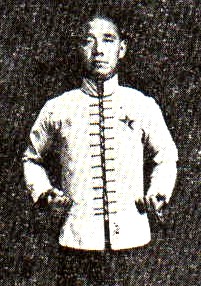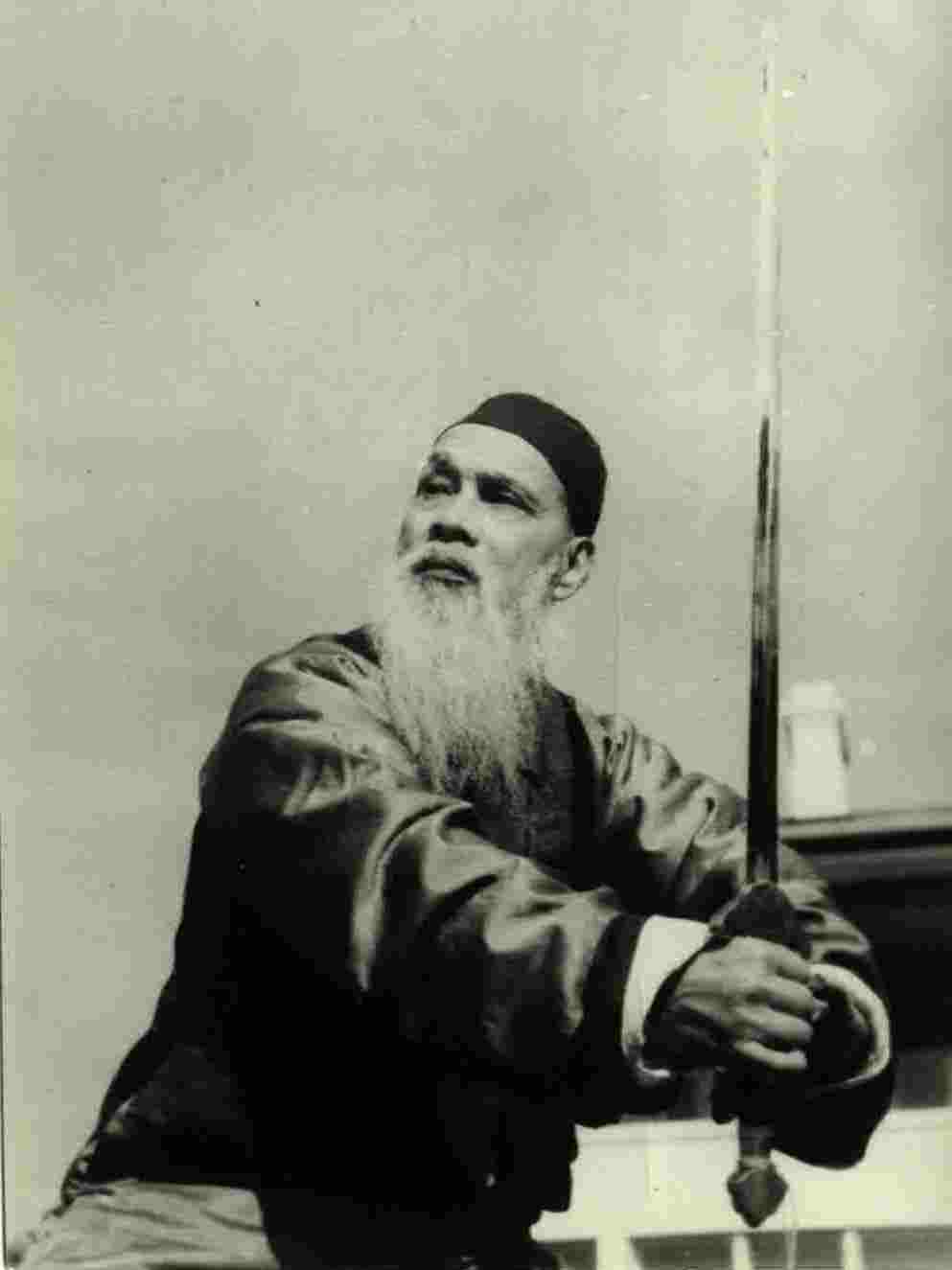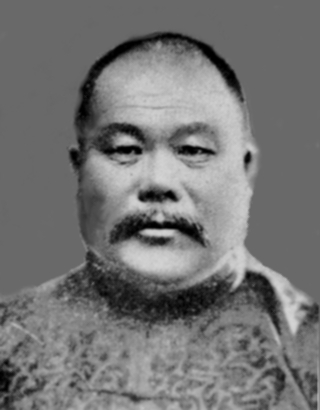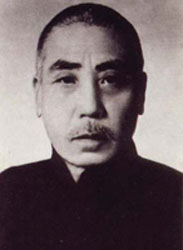SELECTION OF QUESTIONS AND ANSWERS
APRIL 2010 PART 2

Grandmaster Huo Yuan Jia in the kungfu uniform of the world-wide Jing Wu Association, the kungfu school he founded. The picture is reproduced from http://en.wikipedia.org/wiki/Huo_Yuanjia
Question 1
I am a French researcher on famous kungfu fighters of the past and I have one question please. Do you know names of masters, except Wong Fei Hung, Huo Yuan Jia and Yang Lu Chan, born in the 19th century who defeated many challengers in combat during their lives and were undefeated?
— Nicolas, France
Answer
The following are great kungfu fighters born in the 19th century. I could not ascertain the years of birth of the first few, but they were at their height during the burning of the southern Shaolin Temple at Quanzhou and on the Nine-Lotus Mountain around 1850s, and are well known in kungfu circles.
There is no doubt at all about the fighting abilities of those listed below, though not all of them were undefeated throughout their kungfu career. Hoong Hei Koon and Fong Sai Yoke, for example, were defeated by the kungfu genius, Pak Mei.
The last listed, Chai Long Yun, was born after the 19th century, but I list him because he shared the famous characteristic of the other great fighters of the 19th century, i.e. defeating foreign masters who came to China to test her kungfu, and themselves remained undefeated.
The list of course is not exclusive, and is selective. It does not mean that those not listed here were less formidable fighters. It would be too long to list even all the more famous ones. Of the Ten Tigers of Guangdong, for example, only the first one, Tit Kiu Sam, is listed below. I apologize for missing out other worthy names.
It is interesting to note that while Wong Fei Hung (1847-1924) and Huo Yun Jia (1868-1910) were born in the 19th century, Yang Lu Chan (1799-1872) was born right at he end of the 18th century.
The list of great fighters born in the 19th century is as follows.
Venerable Jiang Nan, escaped from the burning of the southern Shaolin Temple at Quanzhou City around 1850s when he was 30 plus, adopted the name "Jiang Nan" to escape notice of the Qing Army which was after him, ran out of China and initiated the Shaolin-Wahnam lineage.
Hoong Hei Koon, one of the 10 great disciples of the secret southern Shaolin Temple on Nine-Lotus Mountain in Fujian, famous for Tiger Style Kungfu, patriarch of Hoong Ka (Hung Gar) Kungfu.
Lok Ah Choy, Manchurian Chinese, one of the 10 great disciples of secret southern Shaolin Temple on Nine-Lotus Mountain in Fujian, teacher of Wong Kai Yin, who was the father and teacher of the famous kungfu master Wong Fei Hoong.
Fong Sai Yoke, one of the 10 great disciples of secret southern Shaolin Temple on Nine-Lotus Mountain in Fujian, famous for no-shadow kicks, won over-night fame when only at 15 killing Lui Da Pang, nick-named Tiger Lui who boasted of sweeping all kungfu of south China.
Miu Chooi Fa, female kungfu master, one of the 10 great disciples of secret southern Shaolin Temple on Nine-Lotus Mountain in Fujian, mother of Foong Sai Yoke, killed by rains of arrows during the burning of the southern Shaolin Temple led by Pak Mei.
Tit Kiu Sam, the first of the Ten Tigers of Guangdong (South China), famous for his powerful arms, creator of the famous Iron Wire Set which develops tremendous internal force.
Yim Wing Choon, female kungfu master, disciple of the Shaolin nun, Venerable Ng Mui, founder of Wing Choong Kungfu.
Chan Harng, disciple of Choy Fook, Li Yau San and Venerable Cheng Chao, founder of Choy-Li-Fatt Kungfu, many of his students helped Dr Sun Yat Sen in the Chinese Revolution.
Wu Yu Xiang, 1813-1880, learned Taijiquan from both Yang Lu Chan and Chen Jing Ping, patriarch of Wu Style Taijiquan, author of "Songs of Secrets for Training of the 13 Techniques".
Venerable Miao Xin, 1836-1934, abbot of Shaolin Temple, master of Lohan Kungfu and Dim Mark, authored a few books like "Origin and Development of Shaolin Kungfu", "Explanation on Shaolin Kungfu" and "Explanation on Shaolin Staff".
Li Chuan Yi, 1846-1921, owner of security-conveyance firm where good kungfu was needed to protect customers' goods from bandits, later joined Boxers' Rebellion, nicked name "Single Sabre Li" for his expertise in using the saber.
Wang Zheng Yi, 1854-1900, being fifth in the family, "wu" in Chinese, he was known as Wang Wu, expert in using a saber, nick-named "Big Sabre Wang Wu".
Lam Sai Weng, 1861-1942, disciple of the famous Wong Fei Hoong, master of Hoong Ka (Hung Gar) Kungfu, instructor of hand-to-hand combat of Chinese Revolutionary Army, author of "Taming the Tiger", "Tiger-Crane" and "Iron Wire Set".
Wang Zi Ping, 1881-1973, Chinese Muslim, master of Shaolin Tantui, expert in horse-riding and archery, due to his internal force he was nick-named "Thousand-Ton Wang", between 1918 and 1921 defeated many foreign masters, including from Russia, Japan and America, he himself was undefeated throughout, Vice-President of China Wushu Federation, authored "20 Techniques of Kungfu" and "20 Techniques for Overcoming Illness and Attaining Longevity".
Yang Deng Fu, 1883-1936, grandson of Yang Lu Chan, transformed Chen Style Taijiquan into Yang Style Taijiquan, author of "Ten Important Points of Taijiquan", published the influential "Yang Style Taijiquan" in 1963 which shaped the form of Yang Style Taijiquan practiced today.
Chen Fa Ke, 1887-1957, lineage-holder of Chen Style Taijiquan from the famous Chen-jia-gou, or Chen Village, fearing that the subtleties of Taijiquan might be lost he created New Form which gave external forms to internal aspects in Chen Style Taijiquan.
Gu Ru Zhang, 1893-1952, master of Northern Shaolin and Tantui, famous for breaking a pile of bricks with his Iron Palm, and killing a horse with a gentle pat leaving no external mark (the horse was brought in by a Russian challenger), defeated many foreign masters, and himself undefeated.
Liu Zhen Sheng, disciple of Huo Yun Jia, expert in Mizongyi (Art of Deceptive Kungfu), defeated masters from Russia and Japan, helped Huo Yun Jia to found Jing Wu Association (Association of the Essence of Martial Arts).
Zhang Zhan Fui, expert in Shaolin, Hsing Yi and Pa Kua, learned Pakua from Tong Hai Chuan, defeated six-time gold medalist Boxer from Germany.
Chai Long Yun, born 1928, expert in Shaolin Huaquan, Taijiquan and Hsing Yi Kungfu, defeated Russian Boxer in 1943 when he was only 14 years old, defeated Boxer from USA in 1946, nick-named "Marvelous Fist", Vice-President of China Wushu Federation, authored many books, including a few series on Huaquan (Hua Kungfu) and "Shaolin Kungfu and Staff".
Question 2
I am trying to get the most out of my practice: most benefits in the least time.
— Alex, USA
Answer
Everything can be viewed in two ways, the negative way and the Shaolin Wahnam way.
Viewing the above statement in a negative way, which most people do, it means the student is trying to rush things.
Unfortunately, this is also what most students do. Typically they go for the most advanced techniques, often learning from books instead of from a living teacher, and expect to know them in quicker time than regular students attending a class. Not only they have no result, they may sometimes derive adverse side-effects.
But this does not apply to you. For you the statement is taken the Shaolin Wahnam way. In fact, it is only logical that any student should aim to get the most out of his practice: most benefits in the least time. This is also the aim of our Shaolin Wahnam instructors. This is what we call smart training.
This is the philosophy behind our claim that our students get more benefits in six months than most other students get in three years. It is also what makes many other people, especially those who never have any exposure to what we learn and teach, very angry. As I have often said, that is their business, and we are not going to waste time arguing with them.
But it is important for us to know why the same statement brings good results for us but adverse effects for others. There are many reasons. One important reason is that we are clear about our art and our aims and objectives, we choose the best available methods for our practice and assess our results periodically, whereas others seldom or never do these things.

Grandmaster Wang Zi Ping defeated many foreign masters and he himself remained undefeated. The picture is reproduced from http://www.masterhelenwu.com/wang.htm .
Question 3
I have many benefits from my training, like a bright spirit, and enthusiasm for life, and a clear mind, and improved vitality, and overall health. I do not have perfect health, and wonder if I should take a step back in training to focus on more self-manifested chi flow to get better results.
Many of my past blockages are gone, but the deep one or two are still present. One relates to my right arm, and one my right leg, resulting in a right knee that easily gets sore. This deep blockage presents itself when I do vigorous chi flow, which is a pretty rare occasion for me lately, causing my right arm to often spin wildly. Sometimes I can feel a good pain in my right elbow after a vigorous chi flow, as the more freely flowing energy is pushing on something in the elbow, probably related to the knee as well.
Answer
Congratulations for the good results.
You are doing very well. There is no need for you to step back. Just carry on the way you have been training.
In fact this is a good principle to follow, i.e. if what you have been doing is bringing good results, carry on as usual; don't make any changes.
This applies not just to kungfu or chi kung training, but to any aspect of life. If a patient is recovering from his illness, he should carry on with the treatment; don't change the medicine or the doctor. If a shop-keeper is getting good business, carry on with the same shop; don't try to change venue.
Nevertheless, if you feel any aspect of your training is particularly useful, like self-manifested chi movement to clear blockage, you may practice it more. This is not making changes; it is making adjustment according to your progress.
Question 4
When I first learned chi-kung from you in 2001 I couldn't even do kungfu or horse stance because it was painful to do so. So clearly I have improved a lot since then physically as well as in other ways.
Answer
You also look, and actually are, much healthier and happier than when I first saw you. I am very glad of your progress.

Grandmaster Yang Deng Fu who transformed Chen Style Taijiquan into Yang Style Taijiquan as popularly practiced today. The picture is reproduced from http://www.polariswushu.net/taijiquan.html.
Question 5
I feel that it is necessary for me to make focused aims and objectives regarding clearing these deeper blockages to fully clear them. What is the best way to approach my training?
Should I continue to practice kungfu and stance training, but dedicate my morning chi-kung session to strictly doing self-manifested chi flow for some time (say three months)? Should I stop kungfu altogether for some time while I focus on self-manifested chi flow? How should I fit my Small and Big Universe practice in with this? What is the best approach?
Answer
I shall give you a holistic answer. Just follow the three golden rules of practice:
- Don't worry.
- Don't intellectualize.
- Enjoy your practice.
In other words, you don't have to worry about your blockage and whether your training will clear it. You also don't have to worry whether you should continue your kungfu training or stop it for some time, or how you should fit in your Small Universe and Big Universe. Just practice whatever exercises you like, including kungfu exercises and Small and Big Universe, or just carry on practicing those exercises that have been bringing you good results.
You don't have to intellectualize on what exercises are best for your results, or what would happen if you choose certain exercises over others.
Carry on your daily practice, and most importantly enjoy it.
What I have said is very good advice, and if you follow it you will have good results. If you ask your seniors, many of them can verify the great benefit of the advice.
But non-Shaolin Wahnam members reading this will be puzzled. I would also like to add that the above advice does not apply to non-Shaolin Wahnam members.
An analogy may make this clear. You have three beautiful cars, a BMW, a Volvo and a Mercedes. It doesn't matter where you want to go -- a restaurant, a supermarket or the seaside -- as long as you drive your car. It doesn't matter whether you drive the BMW, the Volvo or the Mercedes, you will arrive.
Both the journey itself and your arrival at your destination are better if you enjoy your drive. But if you start to worry whether your BMW will be faster than your Volvo, or intellectualize how your Volvo works differently from your Mercedes, not only you will waste time, you may also have complications.
Then why doesn't this analogy apply to other people? They don't have a BMW, a Volvo or a Mercedes. If they have, they don't know how to drive.
Question 6
Something just happened in my practice and I want to make sure what I did was proper. I had just been doing the Small Universe.
I put my arms at my sides to enjoy the small universal flow, and my chi which was glowing at my dan tian didn't move. It just stayed there glowing and charging. At first I tried to make it move, but then I realized I should let it do what it wanted because the chi knows best.
I felt very nice letting the ball of chi at my dan tian charge and intensify. It then did do some circulations around the orbit, but it was like my small universal flow had a mind of its own, and it only wanted to circulate sometimes, at its discretion. However I did notice that the flow was thicker when it did flow around the orbit.
I got a sense that what my small universal flow was doing was something more intelligent, like it knew what it was doing. Perhaps it was charging my dan tian on purpose so that it could make my small universal flow better. It seemed like a form of chi flow, but contained within the form of the small universe core intent: to make my small universal flow complete and full.
I think I was right to allow it to progress the way it did. Is this the proper way to handle this? Should I be letting my small universal flow do as it wants, or should I be insisting that if flows round and round?
Answer
Yes, what you did was correct. Congratulations. You have practiced well.
You can place your hands at your dan tian or at your sides.
All chi kung exercises have two dimension, namely circulating and building, though the emphasis on one or the other dimension is different in different exercises. In the Small Universe, the emphasis is circulating, but the building dimension is also present. What you experienced was this building dimension where chi is built at your dan tian to increase your energy volume.
You can direct the flow the way you want, or let it flow the way it wants. Both ways are correct, and are known as directed flow and free flow respectively.
Editorial Note: Alex's other questions will be posted in the
April 2010 Part 3
issue.

Grandmaster Chen Fa Ke, a direct lineage-holder of Chen Style Taijiquan. The picture is reproduced from http://www.chenshitaiji.com/ecfk.asp .
Question 7
On Amazon I founded two books with the same name, "Chi Kung for Health and Vitality". Which is witch, please?
— Jose, Spain
Answer
The two books with the same title, "Chi Kung for Health and Vitality", are the same books. The book covers are different because one is published by Element Books, and the other by Random House, which bought the publishing rights from Element Books.
My other chi kung book is "The Art of Chi Kung". It also appears in two different book covers, published separately by Element Books and Random House.
Question 8
I have been practicing qigong for a while and found Sifu's books to be very helpful. My girlfriend has very severe eczema. I think qigong would help her but I do not know which exercises would best help eczema. Would you please advise me on what Shoalin Cosmos Qigong exercises may help the most?
— Mark, Australia
Answer
Practicing high-level chi kung should help your girlfriend overcome her health problem.
As the exact cause of your girlfriend's eczema is unknown, using a holistic approach is better than a thematic approach in helping her to overcome her problem. Using a thematic approach means prescribing a particular chi kung exercise to work on a particular part of her body, whereas using a holistic approach means generating an internal energy flow all over her body so that the energy flow will flow to where the problem is.
It may appear odd to the uninitiated but it is true that we do not need to know what is the cause of her problem and where it is exactly located. This is because it is a natural characteristic of energy to flow from high level areas to low level areas. Problem areas are low level areas as there is insufficient energy there to perform natural physiological and psychological functions.
In other words, your girlfriend has severe eczema because her relevant physiological or psychological functions have failed. The functions have failed because the energy needed has been blocked from flowing there, resulting in a low energy level area. If she can successfully and regularly generate a powerful energy flow, the blockage can be cleared and her natural physiological and pyschological functions will be restored, resulting in her overcoming her eczema problem.
A crucial point is not what exercises she should practice but whether she has the skills to generate a powerful energy flow. Obviously she does not have the skills. She has to learn the skills from a qualified instructor. When she has acquired the necessary skills, any chi kung exercise can generate an energy flow, though some exercises are more cost-effective than others.
I would suggest that she attends my Intensive Chi Kung Course.
LINKS
Selected Reading
- It's All about the Little Things
- Developing Internal Force Using Siu Lin Tou
- Four Gates, Floating Clunds and Multiple Armed Attacks
- Shaolin Seven Two Chin-Na Techniques
- How has Chi Kun/shaolin/chin-na.htmlg and the Shaolin Wahnam Institute Change my Life
